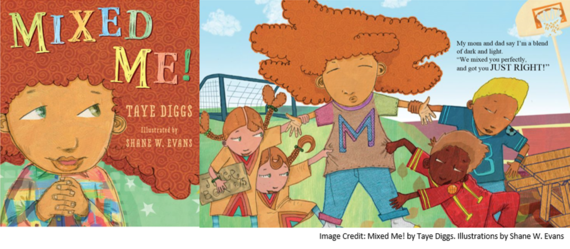
The year was 2002. I'd just landed in Tucson, AZ to present my graduate school research on the "Social Perceptions of Multiracial Children" at the first-ever National Conference on the Multiracial Child in the United States. Hundreds of teachers, mental health professionals, social workers, student organizations, academics, authors and families from all over the U.S. and abroad met for two days of workshops specifically celebrating multiracial children and their histories. Organized by the two largest multiracial advocacy organizations in the U.S. - AMEA (The Association of MultiEthnic Americans) and The Mavin Foundation, we convened to share resources, strengthen collaboratives and then return to our respective fields to expand discussions on diversity and multiculturalism to include those of us strongly identifying with two or more distinct racial backgrounds.
Growing up biracial, I'd learned that negative social perceptions of biracial, multiracial and transracially adopted children were largely impacting the growth, well-being, and resources available to members of our own community at home and in schools. Asserting that biracial children were more "mixed-up" than mixed-race only served to further perpetuate negative stereotypes about us.
But what if mixed-race and biracial children were supported for an identity which embraced both parents?
5 Ways to Support Biracial Children at Home and in School:
1.) Provide resources inclusive of "multiracial" families and mixed-race people when talking about race. Biracial identity is largely molded through available resources and environmental support systems - which is why when asked the "What Are You?" question - biracial and mixed-race individuals along with transracial adoptees across the globe will have different responses. Race is a social construct that's fluid and still evolving. Socioeconomic status, access to parenting resources and multicultural education programs, one's generation (Boomer, Gen X, Millennial...) and geographic region largely impact - if, how and when biracial and multiracial identity is supported or denied.
Actor Taye Diggs (Murder in the First, Private Practice, Broadway's Hedwig and the Angry Inch) is supporting the biracial identity of his six-year-old son through his most recent children's book, Mixed Me! a new resource for children from mixed-race families navigating some of the challenges often faced when asserting biracial or multiracial identity.
Mixed Me! isn't a book only for the mixed-race or multiracial community - it's an excellent multicultural resource which should be introduced to any children (and their caregivers) navigating diversity and identity at home and in schools - especially those unfamiliar with biracial identity and interracial families.
2.) Respect that embracing biracial identity isn't synonymous with rejecting the "minority" parent. One of the most common myths tied to the assertion of biracial identity is the belief that individuals choosing to embrace both sides of their parental heritage must somehow carry a deep-seeded discomfort or disdain of their black (or minority) culture. When instead youth and young adults may simply desire to publicly acknowledge the race of both parents who raised them. Ultimately it should be up to the individual to self-identify with whatever group or groups they come from and feel closest to - free from pressure or even bullying toward "choosing" one group over another. That said, when other mixed-race people choose to identify themselves differently - we should respect wholeheartedly their decision to do so.
3.) Understand that identifying as "biracial" may shift over time. Biracial and mixed-race children may change how they identify themselves to others, but it doesn't necessarily mean they are confused about who they are. The language we use to talk about race and identity expands through adolescence and into adulthood. Children begin to see and can articulate skin-color differences as early as three and four years old. However they aren't yet socialized to place meaning behind those differences unless prompted to do so, - making exposure to resources that support multiracial families and biracial children imperative.
4.) Learn how biracial, mixed-race and transracially adopted children aren't only mixed black and white or from the United States. While the United States and conversations on race are largely polarized between blacks and whites; mixed-race children also represent every other racial/ethnic group across the globe. In Global Mixed Race (NYU Press, 2014), mixed race populations in Zambia, Mexico, Trinidad and Tobago, Kazakhstan, Great Britain, Germany, Japan and Canada are highlighted along with how they are perceived in those regions. The multiracial population is global - even though narratives on our community remain largely underrepresented within mainstream media. The Mixed Remixed Festival website is also a great resource for celebrating stories of the Mixed experience, multiracial and multicultural families and individuals through films, books and performance.
5.) Listen for a variety of different perspectives when it comes to the topic of biracial identity and race. Biracial children and families are far more often talked about in mainstream media than actually heard from - leading to biased or slanted representations about our experiences and interpretations of those experiences. Disney's Big Hero 6 which won the Academy Award for best animated feature, and Kevin Costner's film Black or White provided mainstream audiences with biracial characters who were central to the story-line over the past year. Meanwhile, the #BiracialLooksLike hashtag continues to make its way across social media.
As children become young adults, increased access to resources that support identity development is essential. However multicultural resources inclusive of interracial and transracially adopted children are too often left out of K-12 multicultural education programs and initiatives. If dedicated to promoting inclusive early child education (ECE) programs, initiatives should also include access to a variety of resources that support the health and development of biracial identity and multiracial families too. Teachers and administrators shouldn't hesitate to ask parents how they are approaching the subject of racial identity at home so it can be reinforced appropriately at school.
Kimberly Cooper, MA is a writer, consultant and former chief of operations for the "Reducing Childhood Obesity" initiative - a partnership between First 5 LA and the Los Angeles County Department of Public Health. She's also a former advisory council member for the Association of Multiethnic Americans (AMEA). Her writing has appeared in The Huffington Post, Los Angeles Times, San Francisco Chronicle and Literatigurl.com

